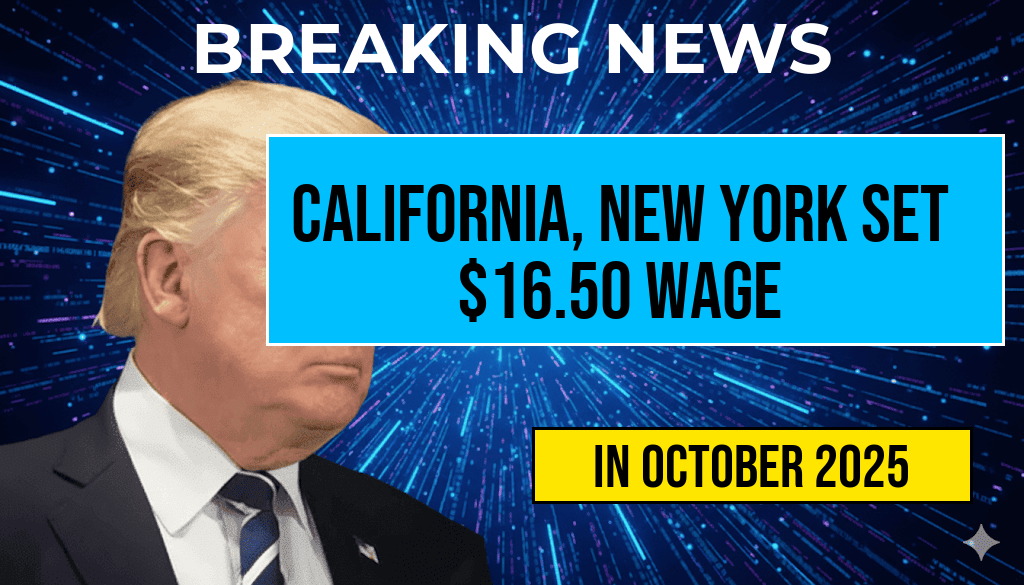California and New York are poised to implement a $16.50 hourly minimum wage, marking a significant step in labor rights for workers in these states. The new wage is set to take effect in January 2024, affecting millions of employees across various sectors. Both states have long been at the forefront of labor reforms, and this latest initiative aligns with their ongoing efforts to provide fair compensation amidst rising living costs. Advocates argue that this increase is essential for ensuring a livable wage, particularly in urban areas where expenses can be exorbitant. However, some business groups express concern about the potential effects on small businesses and the overall economy. As these states prepare for the implementation, discussions continue around the implications for workers and employers alike.
Details of the Minimum Wage Increase
The increase to $16.50 an hour will apply to all non-exempt employees in California and New York, contributing to a broader trend of minimum wage hikes across the country. The following table outlines key details surrounding the implementation:
| State | Effective Date | Current Minimum Wage | New Minimum Wage |
|---|---|---|---|
| California | January 1, 2024 | $15.50 | $16.50 |
| New York | January 1, 2024 | $15.00 | $16.50 |
Rationale Behind the Increase
The push for a $16.50 minimum wage stems from the need to address the high cost of living in both states. Housing, transportation, and healthcare costs have escalated, leaving many workers struggling to make ends meet. Advocates, including labor unions and various community organizations, argue that the increase is a necessary measure to combat poverty and economic disparity.
Support from Labor Groups
Labor groups have consistently supported the wage increase, emphasizing that fair compensation is vital for workers’ well-being. Mary Johnson, a spokesperson for the California Labor Federation, stated, “This increase will significantly impact workers’ lives, providing them with the financial stability they need.” Similar sentiments have been echoed in New York, where local unions are rallying behind the initiative to ensure that employees can support their families.
Concerns from Business Leaders
On the other hand, some business leaders express concern about the potential repercussions of the wage hike. Small businesses, in particular, worry about their ability to absorb the increased labor costs without raising prices or cutting jobs. Tom Williams, president of the Small Business Council of New York, commented, “While we understand the need for a living wage, the timing could not be worse for many small businesses recovering from the pandemic.”
Economic Implications
Economists are divided on the potential impact of the wage increase. Supporters argue that higher wages can lead to increased consumer spending, which in turn can stimulate economic growth. Conversely, critics caution that upward pressure on wages may lead to inflationary effects and could discourage hiring in some sectors.
- Positive Effects: Increased purchasing power for workers, potential rise in consumer spending.
- Negative Effects: Increased costs for businesses, risk of job cuts or price hikes.
Next Steps for Implementation
As January approaches, both states are working on the logistics of implementing the new wage laws. Public awareness campaigns are being launched to inform both employers and employees about the changes. Additionally, state agencies are preparing to enforce the new regulations, ensuring compliance across all industries.
Conclusion
The upcoming minimum wage increase to $16.50 in California and New York represents a significant milestone for labor rights within the United States. As the new year approaches, the attention will focus on how these changes will affect the workforce and the broader economy. Stakeholders from all sides are closely watching to see not only the immediate effects but also the long-term implications for labor standards across the nation.
For further details on minimum wage policies, visit Wikipedia or check out the latest analyses on Forbes.
Frequently Asked Questions
What is the new minimum wage in California and New York?
The new minimum wage in both California and New York will be set at $16.50 per hour.
When will the $16.50 hourly minimum wage take effect?
The implementation date for the $16.50 hourly minimum wage is scheduled for January 2024 in both states.
Who will be affected by the new minimum wage increase?
The increase to $16.50 per hour will affect all workers in California and New York, including those in various industries that are currently paying below this rate.
Are there any exceptions to the minimum wage laws in these states?
Yes, there are some exceptions for certain categories of workers, such as tipped employees and interns, who may have different wage requirements.
How will this minimum wage increase impact businesses?
The increase to $16.50 may lead to higher operational costs for businesses, potentially resulting in increased prices for consumers or adjustments to staffing levels.

Leave a Reply